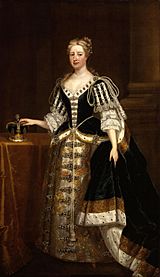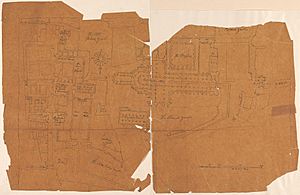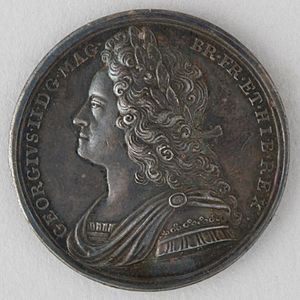Coronation of George II and Caroline facts for kids
|
King George II and Queen Caroline in coronation robes, by Charles Jervas
|
|
| Date | 11/22 October 1727 |
|---|---|
| Location | Westminster Abbey, London, England |
| Budget | £8,720 |
| Participants |
|
A coronation is a special ceremony. It is when a new king or queen officially receives their crown. The coronation of George II and his wife Caroline happened on October 11 or 22, 1727. They became King and Queen of Great Britain and Ireland. The ceremony took place at Westminster Abbey in London.
For this big event, a famous composer named George Frideric Handel wrote four new songs. These songs are called coronation anthems. One of them, Zadok the Priest, has been sung at every British coronation since then. Before the ceremony, there was a grand procession to the Abbey.
Contents
Becoming King and Queen
George became king after his father, George I, passed away. His father died suddenly on June 11, 1727, while visiting his home in Hanover.
Many people worried that the prime minister, Robert Walpole, would lose his job. But Queen Caroline was a strong supporter of Walpole. She told George to keep him in office, and he did. George and Caroline also attended celebrations for Lord Mayor's Day on October 6.
Getting Ready for the Big Day
The coronation was a very expensive event. It cost about £8,720. Traditionally, a special person called the Earl Marshal handles the preparations. This role was usually passed down through families. But the Earl Marshal at the time, Thomas Howard, 8th Duke of Norfolk, was a Roman Catholic. Because of this, he was not allowed to do the job. So, Talbot Yelverton, 1st Earl of Sussex took his place.
Workers built special seating inside Westminster Abbey. This was for 140 visitors from other countries. There were also 60 seats for the choir and musicians. A good seat close to the front cost 10 guineas, which was a lot of money back then. In total, 1,780 people sat inside the Abbey for the coronation.
Newspapers at the time reported that there was a choir of 40 singers. There was also a large orchestra with 160 musicians. Other official records say the total number of musicians and choir members was 185. They performed from temporary stages built above the altar. This was the first time that the music for a coronation was practiced in public. It was also the first time the sheet music was printed for everyone to see.
The Royal Procession
On the morning of the coronation, at 8 am, important people gathered. The peers (high-ranking nobles) met in the House of Lords. The peeresses (wives of peers) met in the Painted Chamber. Other important guests met in the Court of Requests.
Coaches carrying these guests arrived at Westminster Hall. After dropping off their passengers, the coaches left the Abbey area. They went to Hyde Park Corner and returned the same way in the evening.
The Coronation Service
The main ceremony was led by the Archbishop of Canterbury, William Wake. The King and Queen entered the Abbey. The choir and church officials sang a special song.
First, the King was formally recognized by the people. He then made offerings. After some prayers, the Bishop of Oxford gave a sermon. Then, the King took a special oath. He promised to rule fairly.
Next, the King was anointed with holy oil. This oil was placed on his head, chest, and hands. Then, he was given the regalia. These are the special objects of royalty, like the orb and scepter. Finally, the Archbishop placed the crown on his head.
When the King was crowned, the crowd cheered loudly. Trumpets played fanfares inside the Abbey. Guns fired salutes in Green Park and at the Tower of London. The peers put on their small crowns, and the bishops put on their caps. After the peers promised their loyalty, gold medals were given to them. Silver medals were also thrown to the people watching in the Abbey.
Queen Caroline was also anointed with oil and crowned. Her dress was so heavy with jewels that a pulley system was needed to lift her skirt so she could kneel! After the long ceremony, George and Caroline returned to St James's Palace before 8 o'clock that evening.
The Music of the Day
George Frideric Handel was asked to write four anthems for the coronation. These were Zadok the Priest, Let Thy Hand Be Strengthened, The King Shall Rejoice, and My Heart Is Inditing. It was unusual for Handel to be chosen. Usually, the composer for the Chapel Royal would do this. But the person who held that job, William Croft, had recently died. The King reportedly chose Handel, even though Handel didn't have an official court position. Handel had only about four weeks to write all the music! He later used parts of these coronation anthems in his other musical works.
We don't know much about the other music played during the service. One song, "I was glad", might have been accidentally left out. Another piece, a Te Deum, was said to be by "Gibbons." This was probably Orlando Gibbons, a famous composer. Outside the Abbey, people also heard a song called A Song to a Minuet att a Ball on the Happy Coronation Day of George our King.
How People Celebrated
The Dublin Gazette newspaper reported that this coronation was "the most magnificent of any yet seen in England." People celebrated the event by lighting bonfires and setting off fireworks. All over London, flags were displayed to mark the special occasion.





